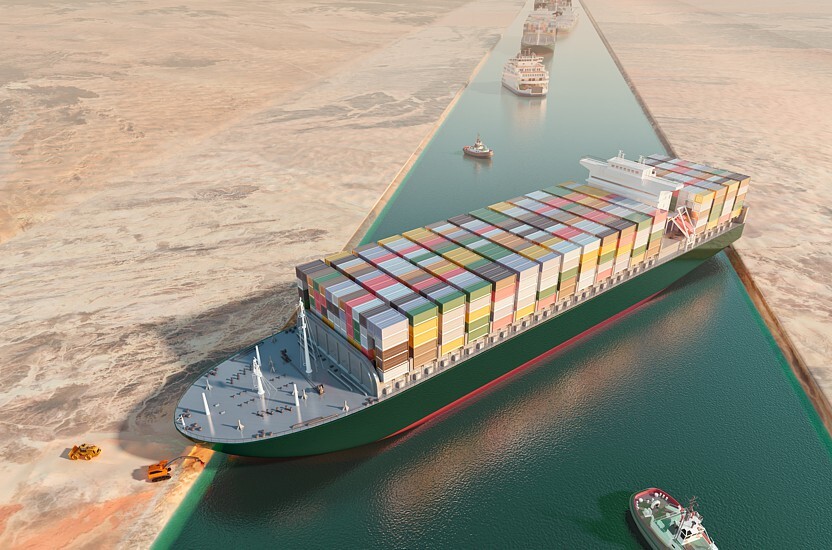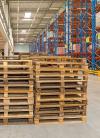Six days - that is exactly how long it took to unblock the container ship Ever Given, which ran aground in the Suez Canal on March 23. As the news agencies point out, one day of downtime in the Suez Canal meant the detention of some 50 ships and 2.5 million tonnes of cargo. Such a disruption not only affected cargo handling times at, for example, the port of Hamburg or Rotterdam but also increased prices and decreased trade.
This major logistical disruption shows how supply chains are interconnected. Each day the Suez Canal was blocked meant that there was a loss of around 14-15 million dollars. This is mainly because 15% of the world's goods are transported by sea pass through the Suez Canal.
Delivery logistics is a network of closely linked operations
Delivery disruptions are a major challenge for both companies and consumers. They also clearly show any weaknesses in the logistics of operations that we are otherwise unaware of when everything is running like a well-oiled machine.
When supply chains are disrupted by various unexpected events, such as the case described above, or the current Covid-19 pandemic, it proves to be a real test of the flexibility of operations. In a study conducted byInstitute for Supply Management nearly 75% of the 628 companies surveyed experienced supply disruptions as a result of the COVID-19 outbreak . In the same survey, 57% of respondents said they face longer lead times from suppliers in China.

In this article, we will look at the causes of disruptions, some ways to prepare for them and possible options for dealing with the lack of necessary packaging carriers.
The impact of Covid-19 on the number of disruptions in supply chains
The impact of the pandemic has taken its toll on the global economy, causing stock prices to fluctuate, which causes lower profit forecasts. So far, the global impact on supply chains has mainly come from the severe situation in China, and we can talk about these impacts in two different ways. First, they affect the supply of raw materials for many manufacturers and retailers around the world, and this is important because China is a huge source of components and finished goods.
The longer factories in China stand idle, the more the global flow of parts and components supplying manufacturers and retailers empties. If the disruption continues, some manufacturers and perhaps even retailers will suspend their operations when they run out of goods.
Prepare for disruption as a permanent part of reality
The importance of resilience in supply chain management has been emphasised for two decades now. This means being able to detect early warning signs, as well as responding quickly by, for example, moving production to alternative sources. It means having a diversified supplier base.
Of course, it's best to plan, but what happens if your supply logistics are currently disrupted and you're wondering how to fix the problems and keep going in the short term?

Having a competent and reliable packaging logistics partner can help you keep your business running. It will help you be more flexible and respond quickly to changes as they occur. Here are some ways we can help your business in these challenging times.
#1 Regularly monitor packaging and adapt to new situations
Transparency in the supply chain is always important but even more so during a crisis. By knowing exactly where pallets and other reusable packaging are at any given time, shippers and their logistics providers can find ways to reroute loads to get ahead of or avoid problem areas.
You can use the workflow management service, which ensures supply chain continuity at every stage. With an integrated transaction management system, we can monitor real data in real-time.
#2 Large packaging stocks available on request
Rotom as a strong supply chain partner has a large packaging inventory, a network of warehouses and more than 26 branches in many European countries. This is positively reflected in terms of operational efficiency compared to companies with fewer resources. As a result, we are able to meet your needs for the necessary number of pallets or storage racks. You can simply rent the necessary amount of packaging for a specified period of time, exactly when you need it. After an intensive period of use, we collect them from you. In this way you avoid costly storage of unused packaging.
On the other hand, with overproduction, if you run out of the required amount of media or your previous packaging supplier fails to provide it, your needs can still be met thanks to a packaging rental service. Leveraging these networks of resources allows you to respond to disruptions faster, stronger and more effectively. This reduces operational downtime and helps you resume operations in the shortest possible time.

#3 Create a supply chain contingency plan
Flexibility and resilience are two key factors that help you prepare for disruption. It is always good to have a contingency plan, especially when it comes to supply. When creating a contingency plan , think about different ways to move goods and consider setting aside a contingency budget that can be used in the event of a disruption.
It's a smart idea for businesses to invest in the resilience of their supply chains - and this has become more important than ever
#4 Estimate available stock
Generally speaking, you should be aware of your available stock at all times; however, this is particularly important in situations where your supply chain is disrupted. It's worth taking a physical inventory of packaging that can ensure continuity of production. Checking the condition of packaging may involve the need for repair or maintenance.
Estimating how much stock you have of consumables and logistics packaging can help you work out how much you need at any one time. If you need extra storage space you can sourcemobile storage racks, set up only when you need them. This also applies to another packaging such as pallets, extensions, containers and many other carriers. If you need a large stock of packaging for a specific period, you can then rent it, so that you can save money for other investments.
#5 Conduct a supply chain resilience audit
Take some time to do a risk analysis and see where the weakest links are in your supply chains. This will help you focus on where you need to find alternatives. It can also be helpful to assess potential environmental, social and political conditions that may affect supply routes. This will help you reduce the risk of not supplying the media you need, e.g. pallets, while also increasing the flexibility of your operations.
Cooperate with a packaging expert
Supply disruptions are inevitable, but by carefully planning your response, assessing potential supply chain risks and diversifying your suppliers, you can prepare for even the most unexpected circumstances.
Finding a trusted packaging partner to help you with these types of challenges is vital. We have been supporting companies in a variety of industries for many years, from sensitive industries such as pharmaceuticals to heavy industry, so our experienced professionals are able to help you find alternative solutions to provide the necessary resilience in your supply chains.


















